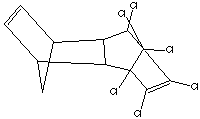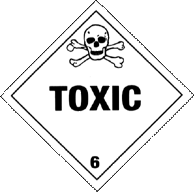Aldrin
- Octalene
- 1,2,3,4,10,10-Hexachloro-1,4,4a,5,8,8a-hexahydro-exo-1,4-endo-5,8-dimethanonaphthalene
- Aldrite
- Seedrin
- HHDN

Aldrin | |
| |
| Formula | C12H8Cl6 |
| Structure |  |
| Description | Aldrin, cast solid is a brown to white solid. |
| Uses | Formerly as insecticide. |
| Registry Numbers and Inventories. | |
| CAS | 309-00-2 |
| EC (EINECS/ELINCS) | 206-215-8 |
| EC Index Number | 602-048-00-3 |
| EC Class | Toxic; Carcinogenic Category 3; Dangerous for the Environment |
| RTECS | IO2100000 |
| RTECS class | Agricultural Chemical and Pesticide; Tumorigen; Mutagen; Reproductive Effector; Human Data |
| UN (DOT) | 2761 |
| Merck | 12,227 |
| Beilstein/Gmelin | 2336652 |
| Beilstein Reference | 3-05-00-01385 |
| RCRA | P004 |
| EPA OPP | 45101 |
| Swiss Giftliste 1 | G-1053 |
| Austrailia AICS | Listed |
| Japan ENCS (MITI) | Listed |
| Properties. | |
| Formula | C12H8Cl6 |
| Formula mass | 364.91 |
| Melting point, °C | 104 |
| Boiling point, °C | 385 |
| Vapor pressure, mmHg | 1E-6 (25 C) |
| Density | 1.7 g/cm3 (20 C) |
| Solubility in water | Insoluble |
| Partition coefficient, pKow | 6.50 |
| Heat of vaporization | 60.9 kJ/mol |
| Hazards and Protection. | |
| Storage | Protect containers against physical damage. Store at in well ventilated, cool, dark place separated from ignition sources. Outdoor or detached storage preferred. |
| Handling | All chemicals should be considered hazardous. Avoid direct physical contact. Use appropriate, approved safety equipment. Untrained individuals should not handle this chemical or its container. Handling should occur in a chemical fume hood. |
| Protection | Wear appropriate protective gloves, clothing and goggles. |
| Respirators | Wear positive pressure self-contained breathing apparatus (SCBA). |
| Small spills/leaks | Keep material out of water sources and sewers. Build dikes to contain flow as necessary. Land spill: Dig a pit, pond, lagoon, holding area to contain liquid or solid material. Cover solids with a plastic sheet to prevent dissolving in rain or fire fighting water. Water spill: Use natural deep water pockets, excavated lagoons, or sand bag barriers to trap material at bottom. If dissolved, in region of 10 ppm or greater concentration, apply activated carbon at ten times the spilled amount. Remove trapped material with suction hoses. Use mechanical dredges or lifts to remove immobilized masses of pollutants and precipitates. |
| Stability | Stable. |
| Incompatibilities | May be sensitive to prolonged exposure to light Reacts with concentrated acids and phenols in the presence of oxidizing agents Corrosive to metals It |
| Decomposition | When heated to decomposition it emits toxic fumes of hydrogen chloride. |
| Fire. | ||||
| Flash Point,°C | 186 | |||
| Fire fighting | Wear full protective clothing, including positive pressure breathing apparatus. Small fires: dry chemical, carbon dioxide, water spray, or foam. Large fires: water spray, fog, or foam. Move container from fire area if you can do so without risk. Fight fire from maximum distance. Dike fire control water for later disposal; do not scatter the material.Not Flammable. Extinguish by using water spray, dry chemical, foam, or carbon dioxide. Use water to keep fire-exposed containers cool. Use water spray to disperse the vapors. | |||
| Fire potential | HIGHLY FLAMMABLE. | |||
| Hazards | When heated to decomposition, it emits toxic fumes of chlorine containing compounds. Commercial solutions may contain flammable or combustible liquids. The dry powder will not burn. Container may explode in heat of fire. Avoid concentrated mineral acids, acid catalysts, acid oxidizing agents, phenols, or active metals. | |||
| Combustion products | Fire may produce irritating, corrosive and/or toxic gases. | |||
| NFPA | Health | 2 | ||
| Flammability | 0 | |||
| Reactivity | 0 | |||
| Health. | |
| Exposure limit(s) | TLV: 0.25 mg/m3 (as TWA), A3 (skin) (ACGIH 1997). OSHA PEL: TWA 0.25 mg/m3 skin NIOSH REL: Ca TWA 0.25 mg/m3 skin See Appendix A NIOSH IDLH: Potential occupational carcinogen 25 mg/m3 |
| Carcinogin | G-A3, CP65 |
| Poison_Class | 2 |
| Exposure effects | Respiratory depression can occur from exposure to aldrin. Fever and recurrent abnormally low blood pressure occurred in acute endrin poisoning. Sensory disturbances, excitation with myoclonic jerking, convulsions, tremor, ataxia, agitation, nervousness, and amnesia may occur. Permanent damage may occur from acute exposure. Aldrin has been fetotoxic and teratogenic in mice and hamsters. Mixed results have been obtained in rats, and it was not teratogenic in dogs. Higher doses have altered the estrus cycle and fertility in rats. Aldrin and dieldrin have been found in human breast milk. |
| Ingestion | Nausea, vomiting, and diarrhea may occur following ingestion. |
| Inhalation | Irritation, reduced gas exchange, and chemical pneumonitis may occur. |
| Skin | Extensive contact results in dermal irritation. Erythematobullous dermatitis has been reported from exposure to aldrin. Generally pure aldrin causes only minor erythema, but commercial formulations may contain more irritating components. |
| Eyes | Hypersalivation and headache may occur. |
First aid |
|
| Ingestion | Seek medical assistance. |
| Inhalation | Move victim to fresh air. Apply artificial respiration if victim is not breathing. Do not use mouth-to-mouth method if victim ingested or inhaled the substance; induce artificial respiration with the aid of a pocket mask equipped with a one-way valve or other proper respiratory medical device. Administer oxygen if breathing is difficult. |
| Skin | Remove and isolate contaminated clothing and shoes. Remove material from skin immediately. Immediately flush with running water for at least 20 minutes. For minor skin contact, avoid spreading material on unaffected skin. |
| Eyes | Irrigate exposed eyes with copious amounts of tepid water for at least 15 minutes. If irritation, pain, swelling, lacrimation, or photophobia persist, the patient should be seen in a health care facility. |
| Transport. | ||
| UN number | 2761 |  |
| Response guide | 151 | |
| Hazard class | 6.1 | |
| Packing Group | I; II; III | |
| USCG CHRIS Code | ALD | |
| Std. Transport # | 4921829 | |